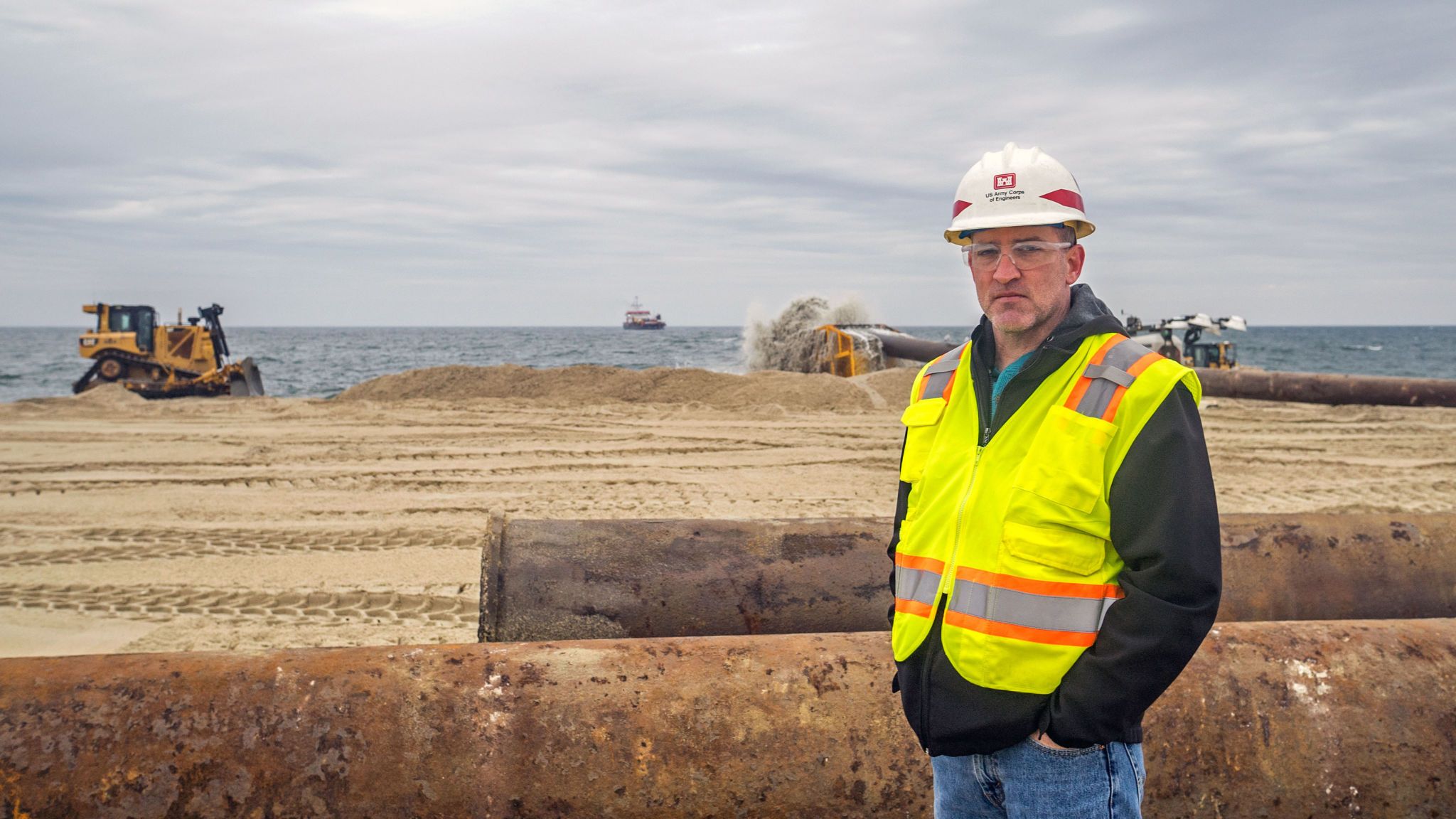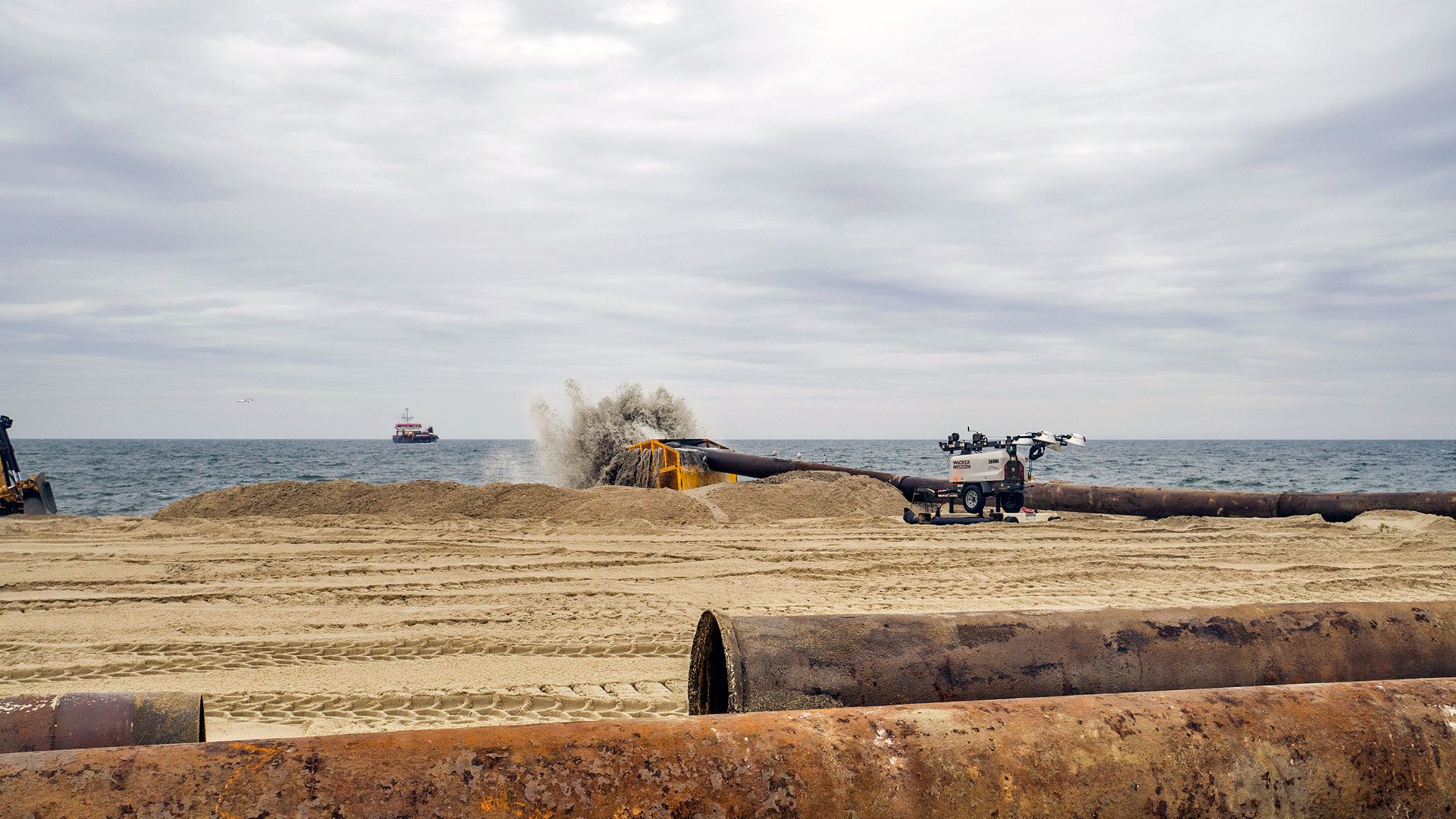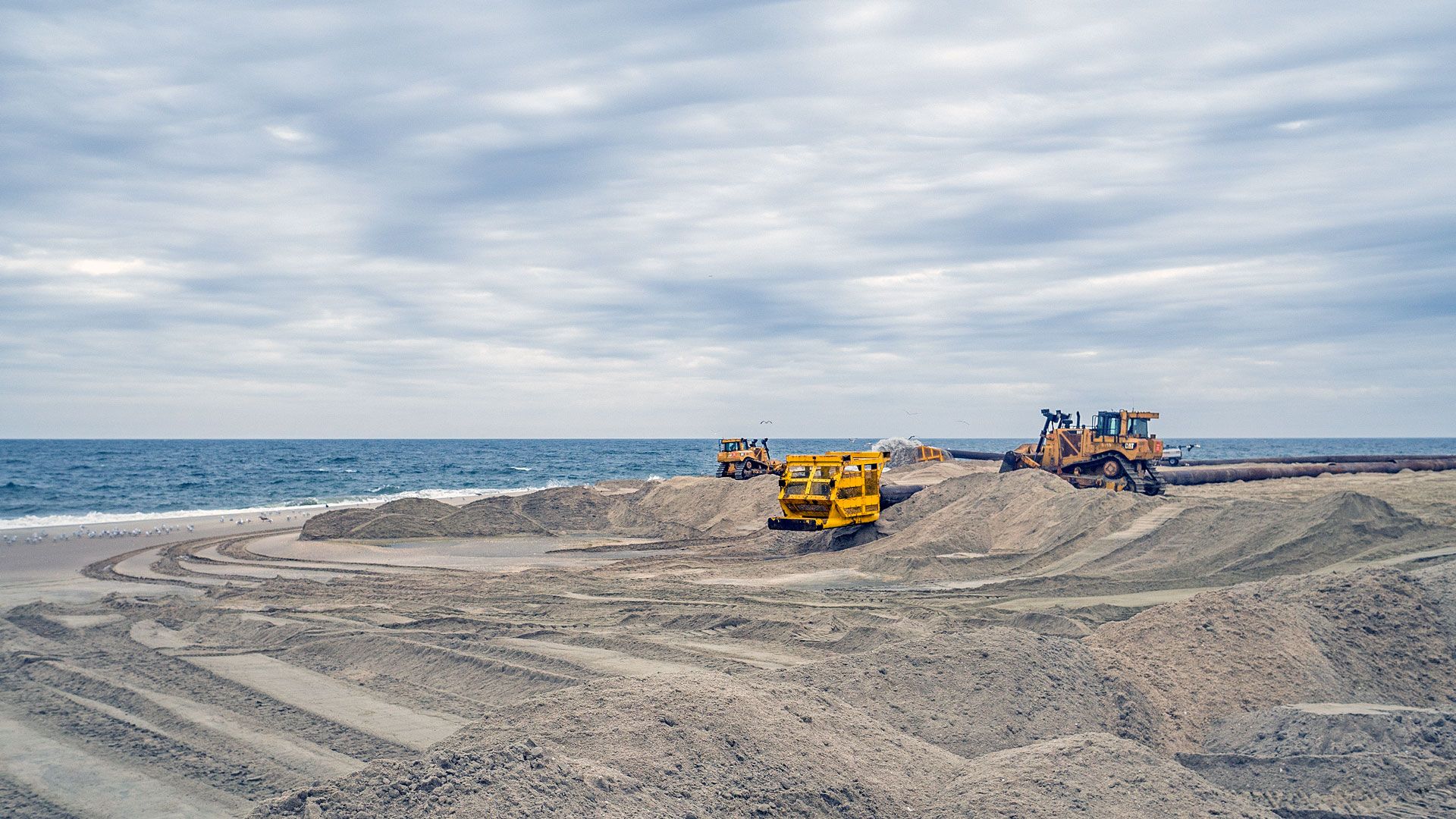On a mild, clear February morning in Sea Bright, the Jersey Shore’s northernmost oceanfront borough, Jason Shea stood on the community’s towering seawall looking satisfied with the view before him. Just to the south, contractors were nearing completion of the Sea Bright portion of a $31.5 million Army Corps of Engineers beach renourishment, of which Shea is the project manager. The task includes pumping 1.6 million cubic yards of sand onto “reaches” in Sea Bright, Monmouth Beach and Long Branch. It is slated to be completed by the end of May.
Originally, the goal was to be done by April, but the contractor — Cranford-based Weeks Marine — has to pick up and head to Florida for between four and six weeks to complete what Shea calls “an emergency job” before returning to finish the Sea Bright and Long Branch reaches. (Monmouth Beach is finished.)
“It won’t be a big impact for the summer season,” Shea said, anticipating concerns of the project hampering the 15 weeks between Memorial and Labor days, when New Jersey’s Atlantic coast municipalities rake in roughly half of the state’s nearly $45 billion in tourism revenues.
Beach renourishment — a familiar sight on the Shore
The delay does not bother Shea, or coastal town managers up and down the Jersey Shore. Once a spectacle that drew curious crowds in the 1990s, when statewide beach renourishment began, these days the sight of phalanxes of excavators scuttling along the shoreline beside huge pipes spewing cascades of grey, sandy slurry is taken for granted. Without it, residents and officials now understand, there would be no Shore as we know it.
Shea appreciates this reality better than most. A few blocks away from the renourishment site is an empty lot, where the building he lived in for a time as a child was inundated by Hurricane Sandy’s storm surge and has since been demolished. “Three houses I lived in as a kid were destroyed by Sandy,” Shea said. “And another one was flooded in the ’92 nor’easter.” He concedes his personal experiences probably nudged him toward a career with the Corps, but what is perhaps left unsaid is the job security that comes with renourishment.
Sandy stripped tens of millions of cubic yards of sand from New Jersey’s beaches, and in the 100 percent federally funded shoreline-rebuilding campaign that followed, the Army Corps has replaced what was lost and then some. Indeed, the statewide post-Sandy project — with help from relatively quiet recent hurricane and nor’easter seasons — has rendered Jersey Shore beaches in better shape than ever, according to Stockton University’s Coastal Research Center, which maintains the most comprehensive data set on the state’s beach profile.
But in the wake of Sandy, the question is no longer if New Jersey’s beaches will need the kind of large-scale renourishment that the Army Corps is conducting in Monmouth County, but how often they will need them — and how much bigger they will need to become. Sea level in New Jersey has risen nearly 1.5 feet since 1911, which is about twice the global average. By 2050, it is likely that sea level will rise by another seven inches, but it could reach two feet. At that point many sections of Shore towns would be underwater on every high tide.
How much sand does $2 billion buy?
Since the 1990s, when the Army Corps of Engineers began inking 50-year cost-sharing beach-building deals with Shore towns — with renourishment cycles that range from every two to seven years, depending on location — nearly $2 billion dollars and about 180 million cubic yards of sand have been dumped onto New Jersey’s beaches in order to keep them from disappearing. (The Sea Bright/Monmouth Beach/Long Branch project was initiated in 1994, meaning renourishment cycles will be considered every six years until 2044.)
Noticing the value of bulkier beaches, especially after Sandy, more and more Shore municipalities — who are on the hook for only a fraction of total project costs thanks to the federal-state-local cost-sharing ratio — are clamoring for the Corps’ services. In addition to the project in Monmouth County, the Army Corps this winter has pumped millions of cubic yards of sand onto beaches in Ocean City, Strathmere, Sea Isle and Avalon. All four towns are located in Cape May County, which has required more renourishment than any other New Jersey county — nearly 70 million cubic yards, or enough sand to fill around 12 MetLife Stadiums.
Despite the ever-increasing need for federally funded shoreline protection projects on New Jersey’s Atlantic coast, as well as many on its back bay and rivers, President Donald Trump’s 2021 budget request calls for a reduction in Army Corps of Engineers funding by $1.7 billion from this year’s appropriation of $7.65 billion. But Trump’s, as well as past presidents’, efforts to slash the Corps budget have, over the past decade at least, been met with resistance from Congress. Ultimately the budgets have ended up higher.
“The recently released FY21 budget does not specifically include funding for (the Sea Bright/Monmouth Beach/Long Branch) project,” Shea said. “But it doesn’t not mean Congress will not appropriate money to the Corps, and the Corps will use what we call ‘Work Plans’ to then fund the projects, which is what happened in fiscal year ’19 and ’20.”
In fact, because of the money received in the fiscal year 2019 and 2020 budgets, Shea believes there will be funding for 1.14 million cubic yards of additional renourishment in “option” areas that have been identified along the 21-mile stretch of beach between the current project sites in Sea Bright and Long Branch. Initiating work in those options of course depends on the state, county and municipalities agreeing to the additional costs, “but in the 20 years of this project, these three municipalities have never turned down a renourishment cycle,” Shea said. If the options are awarded, renourishment would start again in the fall and continue into March 2021.
Renourished beaches — not meant to last
Standing a few dozen yards away from a series of interlocking, 30-inch pipes gushing sand and water onto the beach, Shea explained the surprisingly simple process of renourishment. The pipes connect to the dredge ship Magdalen, which spends its days vacuuming up the kind of fine sand that’s endeared summer beachgoers to the Jersey Shore for generations. It’s pulled from what’s called the Sea Bright Borrow Area, or SBBA, a three-square-mile swath of seafloor a few miles offshore.
From its 8553-cubic-yard hopper, the Magdalen then pumps the slurry onshore, where it is filtered through an elevator-car-sized cage called a “basket.” (The baskets were implemented during the post-Sandy rebuild, when WWII-era munitions turned up in several replenishment projects.) After the Magdalen’s hopper is empty, it heads back out to the borrow area while the Weeks Marine excavators descend like ants, pushing and stretching the mound of deposited sand into wide, flat berms that gently slope into the ocean.
It is easy to think of the operation as standard construction, in which something of permanence is being built. But the reality is, from the moment new sand is pumped onto a beach, the ocean begins to steal it back. “Renourishment,” Shea said, “is not meant to last forever.” If, after a storm like Sandy, damage to a town’s property and infrastructure has been reduced, despite the total loss of its beach, the investment in renourishment is worth it. In that way, up and down the Jersey Shore, communities — and by extension the state and federal government — are engaged in an ever-intensifying, Sisyphean effort.
Just ahead of where the excavators were working, Shea pointed down to one of Sea Bright’s original jetties, built about a century ago, protruding from the beach like old bones. The jetties have been exposed recently, as the shoreline has eroded. But when the replenishment is done, the jetties will once again be buried under six feet of sand. The sight of the new beach towering above the old is a stark reminder of how much work has already gone into keeping the Shore alive, begging the inevitable question: How much higher can the renourishment go?
"That’s a town-by-town question,” Shea said. “Or maybe even house by house.”


